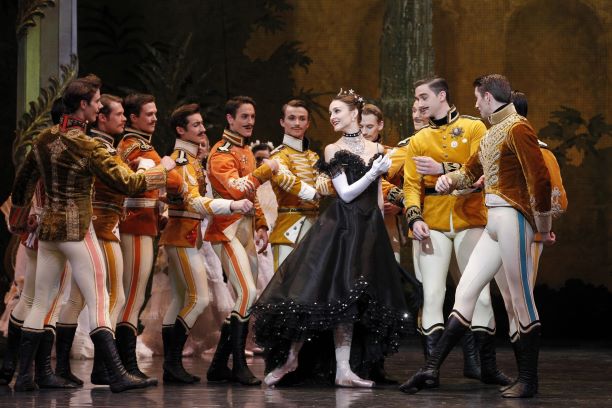19 November 2011, Opera Theatre, Sydney Opera House
Ronald Hynd’s Merry Widow has never been my favourite ballet. I dislike its nature as balletic operetta, with emphasis on the ‘etta’, and its stock comic characters and its silly story line with people hiding in and escaping from pavilions and so forth. And as I took my seat at the Sydney Opera House my companion said, from the perspective of someone whose parents were brought up in 1920s and 1930s Vienna, that she wasn’t looking forward to ‘Viennese schmaltz’, referring in particular to the Franz Lehar music. So I was surprised and delighted to discover that I actually enjoyed the performance (and so did my companion).
Much credit for the way the production sped along goes to the corps de ballet, who were dancing beautifully, and as an ensemble, which doesn’t always happen these days. The Pontevedrian dancers in Act II, especially the men, were outstanding and it was an absolute delight to see everyone engaging with the action even when standing on the sidelines at balls, soirees, and other occasions.
Madeleine Eastoe was delicious as Valencienne. She danced pretty much faultlessly, and what an expressive back she has, which was very much on show in Desmond Heeley’s ball gowns with their deeply cut backs. She gave the role such warmth and charm as she flashed her eyes at a dashing Camille (Andrew Killian), or showed attentiveness to her aged husband Baron Zeta (Colin Peasley).
Colin Peasley’s performance as Baron Zeta had some truly poignant moments. In particular I was moved by his resignation at the close of the ballet to the fact that Valencienne is in love with Camille. It made me wish that he didn’t always have to dance the comic roles—those where his knees always give way when he tries to dance! He has a bit more to offer I think.
On a downside, however, I was disappointed by the performance of Jin Yao, guest artist from the Hong Kong Ballet, as Hanna Glawari. She has beautifully long limbs and carries herself with elegance and her final pas de deux with Count Danilo (Brett Simon) was charming and flowed smoothly. But in general I thought her portrayal of Hanna lacked any warmth. Just a glimmer of what might have been came at the end of the show as she took her curtain call. A little too late unfortunately! Nor was there much strength of characterisation in the scene where Hanna and Danilo realise they are sweethearts from some years earlier and that important scene (important to the storyline) fell a little flat.
I was also disappointed with Matthew Donnelly’s portrayal of Njegus. Donnelly doesn’t seem to have a stage presence that is strong enough to sustain such roles. Or perhaps he needs better coaching or a role model to learn from. His apparent grooming to take on cameo roles of this kind just isn’t working at the moment.
All in all, despite some reservations, which also included for me some jarring aspects in the design, especially in relation to choice of colours, this production of The Merry Widow was a pleasurable experience. Perhaps thanks are due to John Meehan who was guest repetiteur for this production?
Michelle Potter, 20 November 2011
Featured image: Artists of the Australian Ballet in The Merry Widow, 2011. Photo: © Jeff Busby. Courtesy of the Australian Ballet


I couldn’t imagine a world where there wasn’t the possibility of a revival of “The Merry Widow” so I guess I am in a different camp from Michelle. The Melbourne performances carried the same vigour and attack as Michelle describes. And I think part of the excitement, apart from John Meehan’s vigorous overseeing of the restaging, came from the strong dash of paprika in the orchestral playing. No evidence of schmaltz – the strong dance rhythms were very pronounced and the tempi went with a dash. All the choreographic and plot details were sharp and clear as were the performances of the 4 leads and 2 main character roles. My favourite Widow was Rachel Rawlins. Her sharp intelligence and depth of experience allowed her to portray a very well rounded, worldly character. Her gesture of a light “chuck” to Danilo’s chin when they meet again had the most wonderfully human feeling of “same old Danilo” but he’ll get there in the end.
The icy hauteur of Bell was fine for all the glamorous posing, especially her first entrance and solo, but lacked warmth overall for me. Martin was a fine mixture of the glamorous and sentimental. I enjoyed all the Valencienne’s I saw but somehow none captured the sheer verve and excitement, especially in the cakewalk, of former performers such as Anna De Cardi. Certainly a treat for spectators like me who only have “Onegin” to look forward to next year to fulfill our liking of that dreaded category “ballet-opera”.
I am a little envious that you had the opportunity to see Rachel Rawlins. I think the role of Hanna needs a mature person, thinking of Fonteyn here of course. As for ‘Onegin’ next year, I don’t have the same reservations about it as I do/did about ‘Widow’. ‘Onegin’ is ballet-opera rather than ballet-operetta and (in my opinion) is the work of a superior choreographer.
Thank you as ever for your beautifully considered opinions. And it is so good that we don’t all think the same!